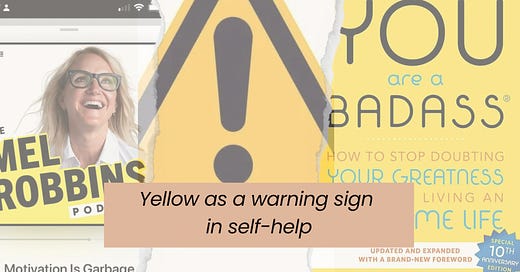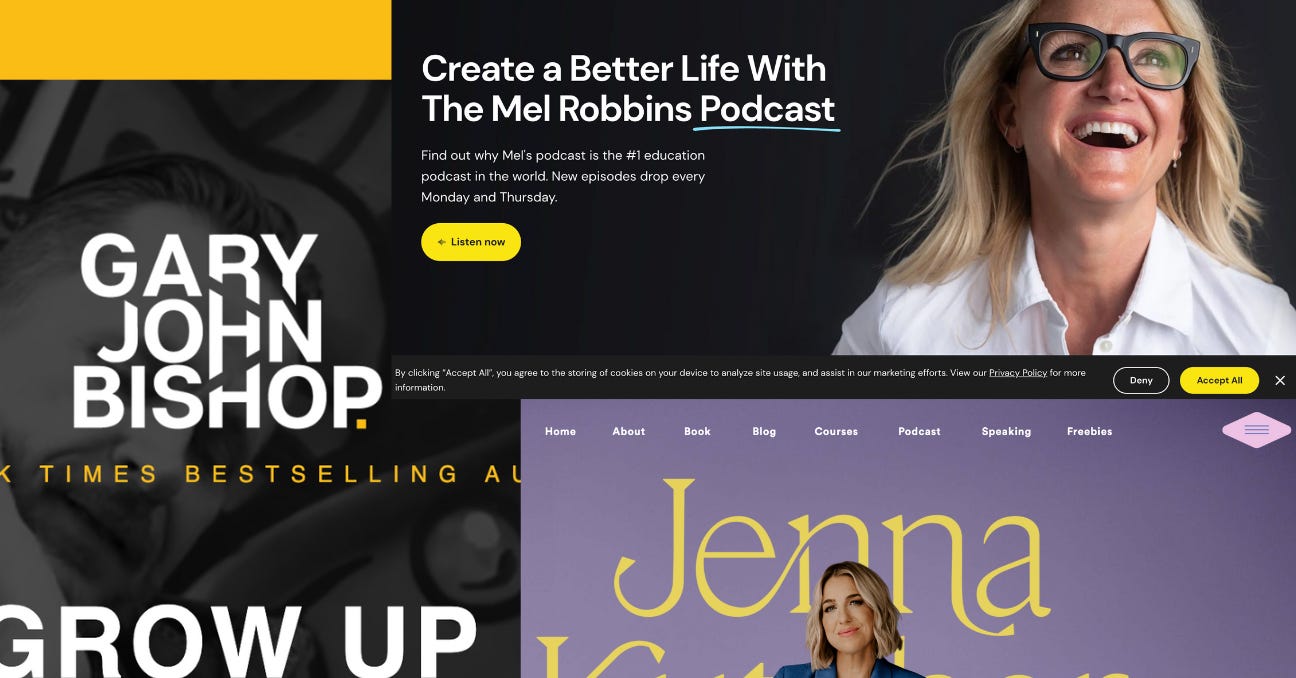Yellow as a warning sign in self-help
A look into the color yellow and it's role in the marketing and manipulation of the self-help industry.
As I was creating a video on self-help books recently, I noticed something strange: every single book had yellow incorporated into its cover. I love the color yellow, but I only see it being used on book covers very sparingly. So, to see it on the cover of every single book stopped me in my tracks.
To make sure it wasn’t a coincidence, I headed on over to the Amazon bestseller list for self-help books and found that 70% of the books in the top 100 books for self-help had the color yellow on the cover.
Then, I made my way into the websites for top self-help “gurus” (including Mel Robbins, Jenna Kutcher, Tony Robbins, Jen Sincero, etc). Of the 30 websites I looked at, 18 of them featured the color yellow on their homepage.
Side-note: Something else interesting that I found was that if the website didn’t feature yellow, I found that orange was used (this was always when the self-help personality was male).
All of this told me that the use of the color yellow was no mistake and, in fact, done on purpose. The question is: why?
An easy answer is that it’s just a trend in the industry and that’s that. But trends don’t come out of thin air. Trends exist, especially in design, because they work. So, let’s dive into why the self-help industry, in particular, loves the color yellow and what what exactly they want to make “work”.
The color theory of yellow
Color theory is all about how colors influence our perception and emotions. The entire self-help industry is literally built to change our perception and emotions (and as we’ve learned here, that usually turns into manipulation and gaslighting). But the perception of self-help material from the very beginning is highly important to individuals wanting to sell you something.
Yellow is a strong color. I think most people would be inclined to agree that yellow is the most attention-grabbing color in the rainbow.
In color theory, the color yellow generally provokes feelings of positivity and happiness. When self-help authors want you to think that everything in your life is actually sunshine and rainbows, invoking the color of sunshine is important. Interestingly enough, orange similarly evokes a feeling of optimism (which fits with what we saw on self-help websites).
Positivity isn’t a bad thing and not something I ever want to discourage. However, the self-help industry doesn’t promote positivity, but toxic positivity. They use positivity to discourage critical thinking, invalidate mental health experiences, and to encourage people to be okay with whatever life and the system throws at them (without question).
Gold is also another hue of yellow and these colors are used almost interchangeably in self-help and I think that the use of gold points to the true motives behind self-help books to begin with. Gold, of course, is the color of money and wealth, which is what most self-help books promise to their readers by encouraging them to just think positively about money and not negatively about people who have money. In reality, the only wealth that self-help books provide is wealth for the author themselves.

What does this mean for you?
It’s clear that choosing yellow as a primary color in books and on websites is an intentional choice of publishers and self-help authors, but so what?
As consumers, I think it’s always good to be aware of 1. What do people want from you? and 2. How are they trying to get it?
The self-help business is projected to be a $56.52 billion industry by 2027. That is, in my opinion, a $56 billion industry that has made money off of people’s vulnerabilities. In order for any business to work, you need repeat customers. So it’s not in the self-help business industry’s interest to actually help anyone. If they did, people wouldn’t buy another book, masterclass, course, etc. Your needs that aren’t being met is what’s keeping the self-help industry afloat.
So what do they want from you? The self-help industry wants you to keep purchasing, to keep you in the loop, and string you on long enough to keep profiting off of you. The real secrets of self-help lie beyond the self and within the community and within mutual aid. But that truth doesn’t make the self-help industry any money. So they will never admit this. Instead, they want you to keep needing so you keep purchasing their products.
And how are they trying to get it? This answer is varied and something we go over in a lot of my deep dives: tactics that self-help authors use to manipulate you into buying more. But one “how” is abundantly clear. While most self-help authors don’t spend a moment talking about actual psychology in their books, they are more than fine using it to sell you something. And one way they do that is with the color psychology of yellow.
I want to be clear, I don’t hate the color yellow. In fact, I love it because it works exactly how it’s supposed to: it just makes me feel happy.
And while yellow mostly exudes joy, it’s important to remember that it can be used in other ways as well.
The most fitting way here? As a warning.
It’s important to remember that yellow is also on warning signs for a reason as well.
So let’s use it as a warning sign. The next time you see yellow on the cover of your next non-fiction book, take a moment to pause. Don’t completely disregard a book (some of my favorite books have the color yellow on the cover), but take a few minutes to research the author and think about the motives of the book itself.
Is the book written to actually help you? Or is the author looking to make money while giving you absolutely nothing?






